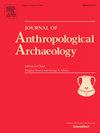芬诺斯坎迪亚驯鹿(Rangifer tarandus)阉割:驯化理论,考古方法和解释观点
IF 2.2
1区 社会学
Q1 ANTHROPOLOGY
引用次数: 0
摘要
阉割驯鹿的传统习俗是过去和现在所有已知驯鹿放牧文化的组成部分。它可能在驯鹿驯化过程中发挥了至关重要的作用,因此,除了狩猎者与猎物的关系外,它还与了解人类与驯鹿最初和后来的互动关系有关。本文介绍了芬兰萨米人和芬兰驯鹿牧民阉割驯鹿的传统知识数据,并通过这一习俗探讨了人与驯鹿的关系,为当前、历史和考古学上关于驯鹿放牧的叙述提供了一个初步的解释框架和多角度的视角。根据阉割对骨骼和鹿茸生长的影响,论文提出了在考古记录中检测阉割的骨学方法。最后,论文将阉割的传统知识与驯化理论相结合,认为阉割是驯鹿驯化的关键因素。首先,阉割似乎是饲养工作用驯鹿所不可或缺的。其次,饲养工作用驯鹿是(发展)驯鹿牧业的基础。第三,本文表明,阉割是牧业的一个基本特征,而不仅仅是使用工作驯鹿。本文讨论了如何通过支配、征服、调解、成长、尊重和伙伴关系等关系,将阉割视为一种全面照顾的形式。本文章由计算机程序翻译,如有差异,请以英文原文为准。
Reindeer (Rangifer tarandus) castration in Fennoscandia: Domestication theory, archaeological methods, and interpretive perspectives
The traditional practice of reindeer castration is an integral component of all known past and present reindeer herding cultures. It has likely played an essential role in the reindeer domestication process, making it relevant for understanding initial and subsequent human-reindeer interactions beyond hunter-prey relationships. This paper presents data on the Traditional Knowledge of reindeer castration among Sámi and Finnish reindeer herders in Finland and explores human-reindeer relations through this practice, providing a tentative interpretative framework and a multi-voiced perspective on current, historical and archaeological narratives of reindeer herding. Based on the effects of castration on bone and antler growth, it proposes osteological methods to detect castration in the archaeological record. Lastly, the paper integrates Traditional Knowledge of castration with domestication theory, arguing that castration is a key element in reindeer domestication. Firstly, castration seems indispensable for the keeping of reindeer for working purposes. Secondly, the keeping of working reindeer is fundamental to (the development of) reindeer pastoralism. Thirdly, this paper shows that castration is an essential feature of pastoralism beyond the use of working reindeer. It is discussed how castration can be seen as a form of holistic care through relations like domination, subjugation, mediation, growth, respect and partnership.
求助全文
通过发布文献求助,成功后即可免费获取论文全文。
去求助
来源期刊

Journal of Anthropological Archaeology
Multiple-
CiteScore
4.00
自引率
11.10%
发文量
64
期刊介绍:
An innovative, international publication, the Journal of Anthropological Archaeology is devoted to the development of theory and, in a broad sense, methodology for the systematic and rigorous understanding of the organization, operation, and evolution of human societies. The discipline served by the journal is characterized by its goals and approach, not by geographical or temporal bounds. The data utilized or treated range from the earliest archaeological evidence for the emergence of human culture to historically documented societies and the contemporary observations of the ethnographer, ethnoarchaeologist, sociologist, or geographer. These subjects appear in the journal as examples of cultural organization, operation, and evolution, not as specific historical phenomena.
 求助内容:
求助内容: 应助结果提醒方式:
应助结果提醒方式:


